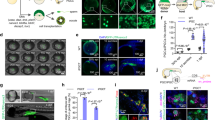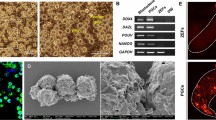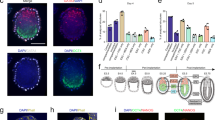Abstract
Although mammals have been cloned from genetically manipulated cultured cells, a comparable achievement has not been realized in lower vertebrates. Here we report that fertile transgenic zebrafish can be obtained by nuclear transfer using embryonic fibroblast cells from long-term cultures. The donor nuclei, modified by retroviral insertions expressing green fluorescent protein (GFP), were transplanted into manually enucleated eggs. Overall, a 2% success rate was achieved, resulting in 11 adult transgenic zebrafish expressing GFP. These nuclear transplants produced fertile, diploid offspring, and their F1/F2 progeny continued to express GFP in a pattern identical to that of the founder fish. This finding demonstrates that slowly dividing nuclei from cultured cells can be reprogrammed to support rapid embryonic development and sets up a foundation for targeted genetic manipulation in zebrafish.
This is a preview of subscription content, access via your institution
Access options
Subscribe to this journal
Receive 12 print issues and online access
$209.00 per year
only $17.42 per issue
Buy this article
- Purchase on Springer Link
- Instant access to full article PDF
Prices may be subject to local taxes which are calculated during checkout




Similar content being viewed by others
References
Amsterdam, A. et al. A large-scale insertional mutagenesis screen in zebrafish. Genes Dev. 13, 2713–2724 (1999).
Long, Q. et al. GATA-1 expression pattern can be recapitulated in living transgenic zebrafish using GFP reporter gene. Development 124, 4105–4111 (1997).
Haffter, P. et al. The identification of genes with unique and essential functions in the development of the zebrafish, Danio rerio. Development 123, 1–36 (1996).
Solnica-Krezel, L. et al. Mutations affecting cell fates and cellular rearrangements during gastrulation in zebrafish. Development 123, 67–80 (1996).
Ma, C., Fan, L., Ganassin, R., Bols, N. & Collodi, P. Production of zebrafish germ-line chimeras from embryo cell cultures. Proc. Natl. Acad. Sci. USA 98, 2461–2466 (2001).
Lai, L. et al. Production of α-1,3-galactosyltransferase knockout pigs by nuclear transfer cloning. Science 295, 1089–1092 (2002).
McCreath, K.J. et al. Production of gene-targeted sheep by nuclear transfer from cultured somatic cells. Nature 405, 1066–1069 (2000).
Briggs, R. & King, T.J. Transplantation of living nuclei from blastula cells into enucleated frog's eggs. Proc. Natl. Acad. Sci. USA 38, 455–463 (1952).
Gurdon, J.B. Nuclear transplantation and the analysis of gene activity in early amphibian development. Adv. Exp. Med. Biol. 62, 35–44 (1975).
Wabl, M.R., Brun, R.B. & Du Pasquier, L. Lymphocytes of the toad Xenopus laevis have the gene set for promoting tadpole development. Science 190, 1310–1312 (1975).
Di Berardino, M.A. & Orr, N.H. Genomic potential of erythroid and leukocytic cells of Rana pipiens analyzed by nuclear transfer into diplotene and maturing oocytes. Differentiation 50, 1–13 (1992).
Orr, N.H., DiBerardino, M.A. & McKinnell, R.G. The genome of frog erythrocytes displays centuplicate replications. Proc. Natl. Acad. Sci. USA 83, 1369–1373 (1986).
Prather, R.S. et al. Nuclear transplantation in the bovine embryo: assessment of donor nuclei and recipient oocyte. Biol. Reprod. 37, 859–866 (1987).
Willadsen, S.M. Nuclear transplantation in sheep embryos. Nature 320, 63–65 (1986).
Stice, S.L. & Robl, J.M. Nuclear reprogramming in nuclear transplant rabbit embryos. Biol. Reprod. 39, 657–664 (1988).
Prather, R.S., Sims, M.M. & First, N.L. Nuclear transplantation in early pig embryos. Biol. Reprod. 41, 414–418 (1989).
Wilmut, I., Schnieke, A.E., McWhir, J., Kind, A.J. & Campbell, K.H. Viable offspring derived from fetal and adult mammalian cells. Nature 385, 810–813 (1997).
Gasaryan, K.G., Hung, N.M., Neyfakh, A.A. & Ivanenkov, V.V. Nuclear transplantation in teleost Misgurnus fossilis L. Nature 280, 585–587 (1979).
Zhu, Z.Y. & Sun, Y.H. Embryonic and genetic manipulation in fish. Cell Res. 10, 17–27 (2000).
Wakamatsu, Y. et al. Fertile and diploid nuclear transplants derived from embryonic cells of a small laboratory fish, medaka Oryzias latipes. Proc. Natl. Acad. Sci. USA 98, 1071–1076 (2001).
Linney, E., Hardison, N.L., Lonze, B.E., Lyons, S. & DiNapoli, L. Transgene expression in zebrafish: a comparison of retroviral-vector and DNA-injection approaches. Dev. Biol. 213, 207–216 (1999).
Cibelli, J.B. et al. Cloned transgenic calves produced from nonquiescent fetal fibroblasts. Science 280, 1256–1258 (1998).
Kasinathan, P., Knott, J.G., Wang, Z., Jerry, D.J. & Robl, J.M. Production of calves from G1 fibroblasts. Nat. Biotechnol. 19, 1176–1178 (2001).
Di Berardino, M. Genomic Potential of Differentiated Cells (Columbia Univ. Press, New York, 1997).
Wang, G. et al. Suppression of heat shock transcription factor HSF1 in zebrafish causes heat-induced apoptosis. Genesis 30, 195–197 (2001).
Sakai, N., Burgess, S. & Hopkins, N. Delayed in vitro fertilization of zebrafish eggs in Hank's saline containing bovine serum albumin. Mol. Mar. Biol. Biotechnol. 6, 84–87 (1997).
Acknowledgements
We thank members of our laboratory for discussion and technical assistance. We thank J. Chen for critically reading the manuscript. This work was supported by a grant from the National Institutes of Health (R01 RR13227) to S.L.
Author information
Authors and Affiliations
Corresponding author
Ethics declarations
Competing interests
The authors declare no competing financial interests.
Rights and permissions
About this article
Cite this article
Lee, KY., Huang, H., Ju, B. et al. Cloned zebrafish by nuclear transfer from long-term-cultured cells. Nat Biotechnol 20, 795–799 (2002). https://doi.org/10.1038/nbt721
Received:
Accepted:
Published:
Issue Date:
DOI: https://doi.org/10.1038/nbt721
This article is cited by
-
TGFβ inhibition and mesenchymal to epithelial transition initiation by Xenopus egg extract: first steps towards early reprogramming in fish somatic cell
Scientific Reports (2023)
-
Study on activity of different tissues from juvenile Yangtze sturgeon in the early post-mortem period
In Vitro Cellular & Developmental Biology - Animal (2022)
-
Embryonic fate after somatic cell nuclear transfer in non-enucleated goldfish oocytes is determined by first cleavages and DNA methylation patterns
Scientific Reports (2021)
-
Somatic cell nuclear transfer in non-enucleated goldfish oocytes: understanding DNA fate during oocyte activation and first cellular division
Scientific Reports (2019)
-
Nuclear import of Xenopus egg extract components into cultured cells for reprogramming purposes: a case study on goldfish fin cells
Scientific Reports (2019)



